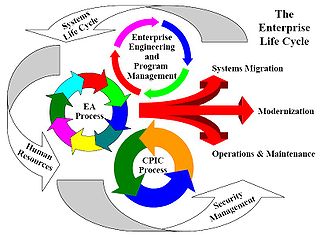In software engineering, multitier architecture is a client–server architecture in which presentation, application processing and data management functions are physically separated. The most widespread use of multitier architecture is the three-tier architecture.

The Zachman Framework is an enterprise ontology and is a fundamental structure for enterprise architecture which provides a formal and structured way of viewing and defining an enterprise. The ontology is a two dimensional classification schema that reflects the intersection between two historical classifications. The first are primitive interrogatives: What, How, When, Who, Where, and Why. The second is derived from the philosophical concept of reification, the transformation of an abstract idea into an instantiation. The Zachman Framework reification transformations are: identification, definition, representation, specification, configuration and instantiation.
Enterprise architecture (EA) is a business function concerned with the structures and behaviors of a business, especially business roles and processes that create and use business data. An Enterprise Architect is at the top level of the architect hierarchy. This means they have more responsibilities than solutions architects. While solutions architects focus on their solution, an enterprise architect focuses on the overview of the whole organization. An enterprise architect leads over many solutions architects and business functions. By international consensus, Enterprise Architecture has been defined as "a well-defined practice for conducting enterprise analysis, design, planning, and implementation, using a comprehensive approach at all times, for the successful development and execution of strategy. Enterprise architecture applies architecture principles and practices to guide organizations through the business, information, process, and technology changes necessary to execute their strategies. These practices utilize the various aspects of an enterprise to identify, motivate, and achieve these changes."

The Open Group Architecture Framework (TOGAF) is the most used framework for enterprise architecture as of 2020 that provides an approach for designing, planning, implementing, and governing an enterprise information technology architecture. TOGAF is a high-level approach to design. It is typically modeled at four levels: Business, Application, Data, and Technology. It relies heavily on modularization, standardization, and already existing, proven technologies and products.

The Department of Defense Architecture Framework (DoDAF) is an architecture framework for the United States Department of Defense (DoD) that provides visualization infrastructure for specific stakeholders concerns through viewpoints organized by various views. These views are artifacts for visualizing, understanding, and assimilating the broad scope and complexities of an architecture description through tabular, structural, behavioral, ontological, pictorial, temporal, graphical, probabilistic, or alternative conceptual means. The current release is DoDAF 2.02.
A federal enterprise architecture framework (FEAF) is the U.S. reference enterprise architecture of a federal government. It provides a common approach for the integration of strategic, business and technology management as part of organization design and performance improvement.
Data architecture consist of models, policies, rules, and standards that govern which data is collected and how it is stored, arranged, integrated, and put to use in data systems and in organizations. Data is usually one of several architecture domains that form the pillars of an enterprise architecture or solution architecture.

An enterprise architecture framework defines how to create and use an enterprise architecture. An architecture framework provides principles and practices for creating and using the architecture description of a system. It structures architects' thinking by dividing the architecture description into domains, layers, or views, and offers models - typically matrices and diagrams - for documenting each view. This allows for making systemic design decisions on all the components of the system and making long-term decisions around new design requirements, sustainability, and support.

Enterprise modelling is the abstract representation, description and definition of the structure, processes, information and resources of an identifiable business, government body, or other large organization.
Frameworx is an enterprise architecture framework geared towards communications service providers.
In information systems, applications architecture or application architecture is one of several architecture domains that form the pillars of an enterprise architecture (EA).

In systems engineering, software engineering, and computer science, a function model or functional model is a structured representation of the functions within the modeled system or subject area.

Enterprise life cycle (ELC) in enterprise architecture is the dynamic, iterative process of changing the enterprise over time by incorporating new business processes, new technology, and new capabilities, as well as maintenance, disposition and disposal of existing elements of the enterprise.

A view model or viewpoints framework in systems engineering, software engineering, and enterprise engineering is a framework which defines a coherent set of views to be used in the construction of a system architecture, software architecture, or enterprise architecture. A view is a representation of the whole system from the perspective of a related set of concerns.

Treasury Enterprise Architecture Framework (TEAF) was an enterprise architecture framework for treasury, based on the Zachman Framework. It was developed by the US Department of the Treasury and published in July 2000. May 2012 this framework has been subsumed by evolving Federal Enterprise Architecture Policy as documented in "The Common Approach to Federal Enterprise Architecture".

Operational View (OV) is one of the basic views defined in the enterprise architecture (EA) of the Department of Defense Architecture Framework V1.5 (DoDAF) and is related with concept of operations. Under DODAF 2, which became operational in 2009, the collections of views are now termed 'viewpoints' and no longer views.

FDIC Enterprise Architecture Framework was the enterprise architecture framework of the United States Federal Deposit Insurance Corporation (FDIC). A lot of the current article is about the enterprise architecture framework developed around 2005, and currently anno 2011 out-of-date.

Enterprise architecture planning (EAP) in enterprise architecture is the planning process of defining architectures for the use of information in support of the business and the plan for implementing those architectures.

NIST Enterprise Architecture Model is a late-1980s reference model for enterprise architecture. It defines an enterprise architecture by the interrelationship between an enterprise's business, information, and technology environments.

The Treasury Information System Architecture Framework (TISAF) is an early 1990s Enterprise Architecture framework to assist US Treasury Bureaus to develop their Enterprise Information System Architectures (EISAs).















